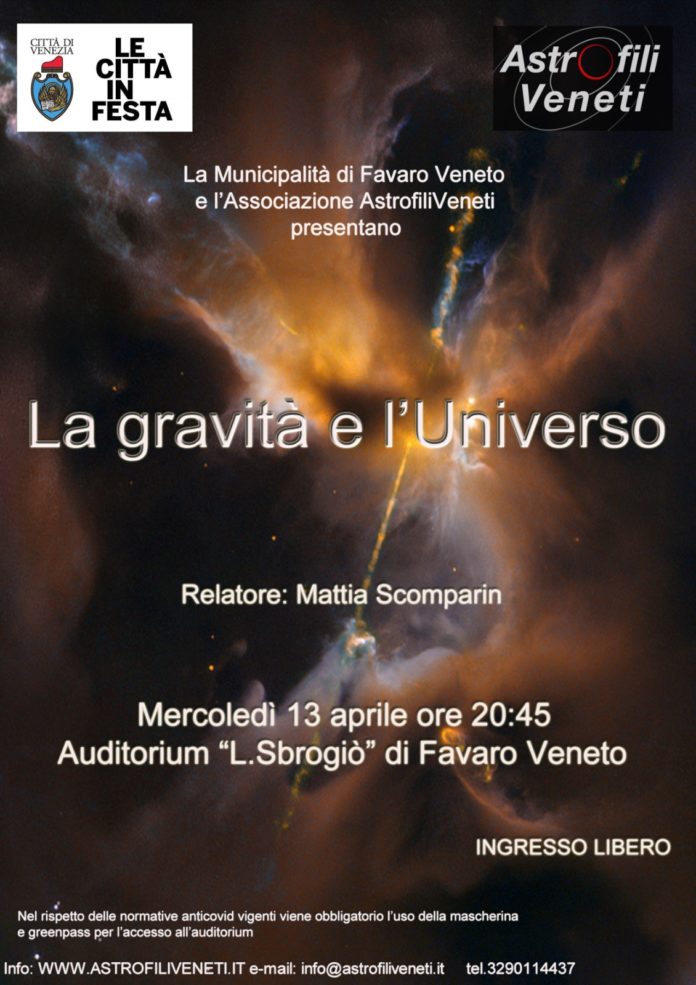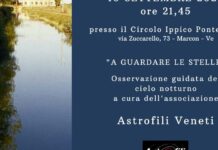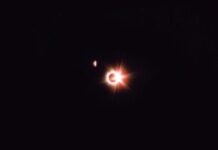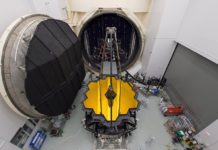Il 13 aprile u.s., a Favaro Veneto, c’è stata una conferenza organizzata dall’associazione Astrofili Veneti e patrocinato da “Le Città in Festa”. La conferenza aveva per titolo La gravità e l’universo, e il relatore era Mattia Scomparin, degli Astrofili Veneti (ai quali mi sono iscritto).
Dopo aver parlato di cosa fa un fisico teorico, Mattia ha toccato la legge di Hubble, il principio cosmologico (a distanze sufficientemente grandi l’universo è omogeneo e isotropo), il fattore di scala e infine l’equazione di campo di Einstein e la curvatura dello spaziotempo. Il tutto in modo molto leggero e comprensibile, nonché divertente, come deve essere in una conferenza aperta al grande pubblico. Una conferenza brillante, perfetta (*).
Mattia si è laureato e ha conseguito il dottorato al Dipartimento di Fisica e Astronomia “Galileo Galilei” dell’Università di Padova. Attualmente lavora presso la EIE Group srl di Mestre, ditta all’avanguardia in tutto il mondo per la realizzazione degli strumenti e delle strutture esterne di molti dei grandi progetti di telescopi e radiotelescopi molto noti in ambito astrofisico come ALMA, LBT, VLT, LSST e il gigantesco ELT. Si dedica principalmente alla fisica della gravitazione, sia nell’ambito della relatività generale e della cosmologia che in settori più di frontiera come le cosiddette teorie della gravitazione f(R), lo studio delle onde gravitazionali, e alcuni problemi di meccanica quantistica. Inoltre porta avanti ricerche di matematica applicata alla fisica, riguardo soprattutto alla meccanica lagrangiana e alle soluzioni delle equazioni differenziali ordinarie.
Su Researchgate.net sono presenti otto sue pubblicazioni, alcune direttamente scaricabili, che danno un’idea delle sue competenze come fisico teorico. Questi i titoli delle pubblicazioni con il loro abstract così come da Researchgate.net:
Mattia Scomparin, New nonlocal constants and first integrals for nonlinear Jacobi-type equations (marzo 2022)
We prove a set of general theorems that provide new nonlocal constants and first integrals for nonlinear Jacobi-type ordinary differential equations. Applications include equations of the Painleve-Gambier classification.
Gianluca Gorni, Mattia Scomparin, Gaetano Zampieri, Nonlocal constants of motion in Lagrangian Dynamics of any order (aprile 2021, gennaio 2022)
We describe a recipe to generate “nonlocal” constants of motion for ODE (Ordinary Differential Equations, equazioni differenziali ordinarie) Lagrangian systems. As a sample application, we recall a nonlocal constant of motion for dissipative mechanical systems, from which we can deduce global existence and estimates of solutions under fairly general assumptions. Then we review a generalization to Euler–Lagrange ODEs of order higher than two, leading to first integrals for the Pais-Uhlenbeck oscillator and other systems. Future developments may include adaptations of the theory to Euler–Lagrange PDEs (Partial Differential Equations, equazioni differenziali alle derivate parziali).
Simone Vazzoler, Mattia Scomparin, Coherent states approximation and semiclassical limit (marzo 2021)
We present some links between the semiclassical approximation of quantum mechanics and classical mechanics. We start by examining the most classical states of quantum mechanics (the so-called coherent states) and we then give some results on semiclassical approximation of the solutions of Schrödinger equation using coherent states. Next, we extend the main result to the superposition of multiple coherent states, and we present some examples of this approximation around a stable and an unstable point of the classical flow.
Mattia Scomparin, Cosmic structures in Ricci-inverse theories of gravity (febbraio 2021)
We discuss a no-go theorem for the novel Ricci-inverse theory of gravity. Referring to a static spherically symmetric matter distribution embedded in a de Sitter cosmology, we prove that it is impossible to have a stable Sub-Horizon non-relativistic Weak-Field limit in any model proposed in previous works to avoid some cosmological and inflationary instabilities. We discuss possible ways to circumvent the issue, and point out a machinery to build new stable models under Sub-Horizon non-relativistic Weak-Field limit. Such models exhibit full consistency with predictions of General Relativity on small scales.
Mattia Scomparin, Nonlocal constants of motion and first integrals in higher-order Lagrangian Dynamics (gennaio 2021)
We generalize the theory of nonlocal constants of motion to higher-order Lagrangian Dynamics. Novel first integrals are discovered, standard noetherian results are recovered. Applications include Pais-Uhlenbeck oscillator and models of modified gravity.
Mattia Scomparin, Simone Vazzoler, Damping of cosmological tensor modes in Horndeski theories after GW170817 (marzo 2019)
This paper investigates the propagation of cosmological gravitational waves interacting with free-streaming neutrinos within the context of Horndeski theories of gravity constrained by the detection of GW170817. We apply the theory of cosmological perturbations to explicitly derive the Einstein-Boltzmann equation for the damped propagation of first-order transverse traceless gravitational waves. In contrast to general relativity, we argue that modified gravity can give rise to non-vanishing free-streaming damping effects during the cosmological matter dominated era. We also provide an analytic formula for the main multipole order with which modified gravity and free-streaming neutrinos damp the variety of tensor correlation functions of the cosmic microwave background.
Nicola Bartolo, Purnendu Karmakar, Sabino Matarrese, Mattia Scomparin, Cosmic structures and gravitational waves in ghost-free scalar-tensor theories of gravity (dicembre 2017)
We study cosmic structures in the quadratic Degenerate Higher Order Scalar Tensor (qDHOST) model, which has been proposed as the most general scalar-tensor theory (up to quadratic dependence on the covariant derivatives of the scalar field), which is not plagued by the presence of ghost instabilities. We then study a static, spherically symmetric object embedded in de Sitter space-time for the qDHOST model. This model exhibits breaking of the Vainshtein mechanism inside the cosmic structure and Schwarzschild-de Sitter space-time outside, where General Relativity (GR) can be recovered within the Vainshtein radius. We then look for the conditions on the parameters on the considered qDHOST scenario which ensure the validity of the Vainshtein screening mechanism inside the object and the fulfilment of the recent GW170817/GRB170817A (GW: Gravitational Wave, onda gravitazionale; GRB: Gamma Ray Burst, esplosione di raggi gamma) constraint on the speed of propagation of gravitational waves. We find that these two constraints rule out the same set of parameters, corresponding to the Lagrangians that are quadratic in second-order derivatives of the scalar field, for the shift symmetric qDHOST.
(*) La cosa più apprezzabile della conferenza di Mattia è stata il fatto che non si è mai appiattita in una certa divulgazione talmente edulcorata da diventare banale, la divulgazione per intendersi dell'”uvetta nel panettone” e del “forno per la pizza”. In genere la gente che cerchi un po’ di approfondire, andando un minimo oltre questo livello base, senza lasciarsi scoraggiare dalla matematica, è lasciata a se stessa. Da una parte il discorso “divulgativo”, che cercando di essere comprensibile a tutti finisce per non dire nulla a nessuno, e dall’altra il discorso “tecnico”, talmente complesso da essere del tutto inavvicinabile per un profano. Senza nulla in mezzo.
https://www.researchgate.net/profile/Mattia-Scomparin (con download)
https://en.wikipedia.org/wiki/F(R)_gravity
https://en.wikipedia.org/wiki/Scalar_curvature
http://www.johnboccio.com/courses/Physics130_2013/Alternative_GR/fR_1.pdf (download)
https://en.wikipedia.org/wiki/Painlevé_transcendents
https://www.academia.edu/49036623/
Solutions_of_the_Duffing_and_Painlevé_Gambier_Equations_by_Generalized_Sundman_Transformation (download)
https://en.wikipedia.org/wiki/Semiclassical_physics
https://en.wikipedia.org/wiki/GW170817
https://www.eie.it/







